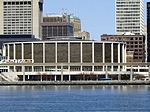Siege of Fort Detroit
1763 in North AmericaBattles in MichiganBattles of Pontiac's WarConflicts in 1763Detroit River ... and 3 more
History of DetroitSieges involving Great BritainUse mdy dates from May 2022

The siege of Fort Detroit was an ultimately unsuccessful attempt by North American Indians to capture Fort Detroit during Pontiac's Rebellion. The siege was led primarily by Pontiac, an Ottawa chief and military leader. This rebellion would be one of the catalysts that hastened the declaration of the Proclamation of 1763 which would eventually precipitate the events leading to the American Revolution.
Excerpt from the Wikipedia article Siege of Fort Detroit (License: CC BY-SA 3.0, Authors, Images).Siege of Fort Detroit
Washington Boulevard, Detroit
Geographical coordinates (GPS) Address Phone number Nearby Places Show on map
Geographical coordinates (GPS)
| Latitude | Longitude |
|---|---|
| N 42.328055555556 ° | E -83.047777777778 ° |
Address
Crowne Plaza Detroit Downtown Riverfront
Washington Boulevard 2
48226 Detroit
Michigan, United States
Open on Google Maps










